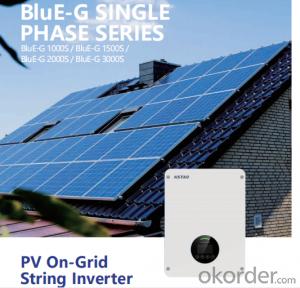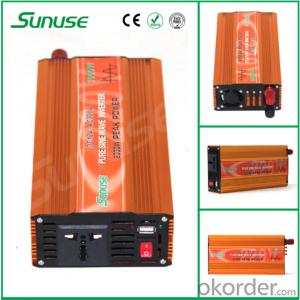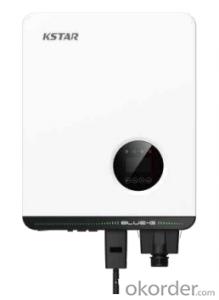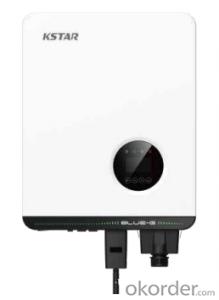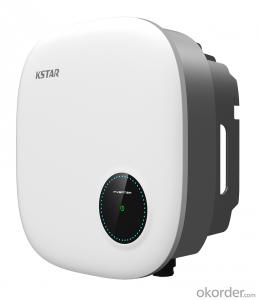PWM Solar Inverter PV On-Grid String Inverter Blue-G 1000S / Blue-G 1500S / Blue-G 2000S / Blue-G 3000S
- Loading Port:
- China main port
- Payment Terms:
- TT OR LC
- Min Order Qty:
- 50 pc
- Supply Capability:
- 15000 pc/month
OKorder Service Pledge
OKorder Financial Service
You Might Also Like
Specification
Product Description:
★Max. PV voltage up to 600V DC/AC ratio up to 1.5
★High efficiency up to 97.6% Smaller and lighter
★Type II DC SPD/Type III AC SPD IP65 protection
★Compatible for big capacity PV panel WiFi / 4G Plug optional
| MODEL | BluE-G 1000S | BluE-G 1500S | BluE-G 2000S | BluE-G 3000S |
| Input(DC) | ||||
| Max. DC voltage | 600Vdc | 600Vdc | 600Vdc | 600Vdc |
| Nominal voltage | 380Vdc | 380Vdc | 380Vdc | 380Vdc |
| Start voltage | 80V | 80V | 80V | 80V |
| MPPT voltage range | 80V-560V | 80V-560V | 80V-560V | 80V-560V |
| Number of MPP tracker | 1 | 1 | 1 | 1 |
| Strings per MPP tracker | 1 | 1 | 1 | 1 |
| Max. input current per MPPT | 15A | 15A | 15A | 15A |
| Max. short-circuit current per MPPT | 18A | 18A | 18A | 18A |
| Output(AC) | ||||
| Nominal AC output power | 1000W | 1500W | 2000W | 3000W |
| Max. AC apparent power | 1000VA | 1650VA | 2200VA | 3300VA |
| Nominal AC voltage | 230V L-N | 230V L-N | 230V L-N | 230V L-N |
| AC grid frequency range | 50Hz / 60Hz±5Hz | 50Hz / 60Hz±5Hz | 50Hz / 60Hz±5Hz | 50Hz / 60Hz±5Hz |
| Max. Output Current (A) | 4.8A | 7.2A | 9.6A | 14.4A |
| Power factor (cos ) | 0.8 leading to 0.8 lagging | |||
| THDi | <3% | |||
| Efficiency | ||||
| Max. efficiency | 97.00% | 97.50% | 97.50% | 97.60% |
| Euro efficiency | 96.50% | 97.00% | 97.00% | 97.00% |
| Protection devices | ||||
| DC switch | Yes | Yes | Yes | Yes |
| Anti-islanding protection | Yes | Yes | Yes | Yes |
| Output over current | Yes | Yes | Yes | Yes |
| DC reverse polarity protection | Yes | Yes | Yes | Yes |
| String fault Detection | Yes | Yes | Yes | Yes |
| Surge protection | DC Type III;AC Type III | |||
| Insulation detection | Yes | Yes | Yes | Yes |
| AC short circuit protection | Yes | Yes | Yes | Yes |
| General Specifications | ||||
| Dimensions W x H x D (mm) | 350*290*120mm | |||
| Weight(kg) | 7.3kg | 8kg | 8kg | 8kg |
| Environment | ||||
| Operating temperature range | –25℃~+60℃ | |||
| Cooling type | Natural | |||
| Max. operation altitude | 4000m | |||
| Max. operation humidity | 0-100% | |||
| AC Output terminal type | Quick connector | |||
| Topology | IP65 | |||
| IP class | Transformer-less | |||
| Communication Interface | RS485/WIFI/4G | |||
| Display | LCD | |||
| Certification & Standard | EN/IEC62109-1/2;IEC/EN61000-6-2;IEC/EN61000-6-4;IEC62116;IEC61727;EN50549-1 | |||
FAQ:
Q:How the output voltage of the PV inverter and the grid-connected voltage are determined
Inverter is the DC power (battery, battery) into alternating current (usually 220V, 50Hz sine wave). It consists of inverter bridge, control logic and filter circuit. Widely used in air conditioning, home theater, electric wheel, power tools, sewing machines, DVD, VCD, computer, TV, washing machine, range hood, refrigerator, video recorders, massage, fan, lighting and so on. In foreign countries
Q:Installation and maintenance of photovoltaic grid - connected inverter
only when the local power sector permission by the professional and technical personnel to complete all the electrical connection before the inverter can be connected.
Q:What is the difference between a PV grid-connected inverter and an off-grid inverter?
Off-grid inverter is equivalent to their own to establish an independent small power grid, mainly to control their own voltage, is a voltage source.
Q:After the PV inverter, how to achieve the same period before the network?
Solar panel simulator: with MPPT function, simulated morning, noon, afternoon, evening, rainy weather, solar panels produced under different conditions in different voltages.
Q:Is the PV inverter a current source or a voltage source?
According to the waveform modulation method can be divided into square wave inverter, stepped wave inverter, sine wave inverter and modular three-phase inverter.
Q:Photovoltaic grid-connected inverter without DC emc how will happen
Solar photovoltaic power generation technology is the use of solar cells, the photovoltaic effect of semiconductor materials, solar radiation can be directly converted into a new type of power generation system, solar energy is a radiant energy, solar power means --- to direct conversion of sunlight Into electricity,
Q:What is the difference between low voltage grid connection and medium voltage grid connection?
For photovoltaic power plants when the power system accidents or disturbances caused by photovoltaic power plant grid voltage drop, in a certain voltage drop range and time interval, the photovoltaic power plant can ensure that non-off-line continuous operation.
Q:Is the grid side of the grid and the inverter?
The grid load side of the grid is the grid. The inverter is an important part of the PV grid-connected system and can not be regarded as an external load. Photovoltaic power generation system is included in both grid and off-grid.
Q:PV grid-connected inverter and independent inverter in the control of what is the difference
The independent inverter in the output voltage phase amplitude of the frequency control is initially set good. Independent inverter, you should refer to off-grid inverter, do not need to consider the grid situation.
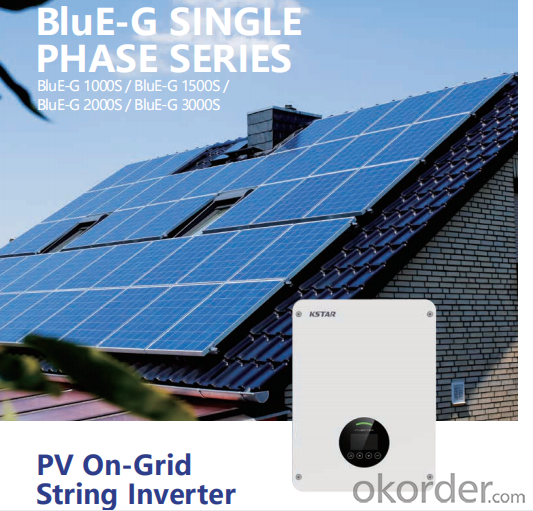
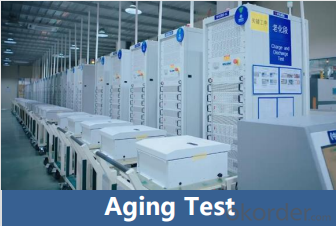

- Q: Can a solar inverter be used in regions with high levels of lightning activity?
- Yes, a solar inverter can be used in regions with high levels of lightning activity. However, it is important to install appropriate lightning protection measures to ensure the safety and functionality of the solar inverter system. This can include surge protection devices and grounding systems to mitigate potential damage caused by lightning strikes.
- Q: Can a solar inverter be used with different types of solar panels?
- Yes, a solar inverter can be used with different types of solar panels as long as the voltage and current specifications of the panels are compatible with the inverter.
- Q: How does a solar inverter handle voltage sags or swells in the grid?
- A solar inverter handles voltage sags or swells in the grid by continuously monitoring the grid voltage. When a sag or swell is detected, the inverter adjusts its output voltage accordingly to maintain a stable and consistent supply of power. It does this by regulating the amount of power it injects into the grid or by temporarily disconnecting from the grid to protect itself and other connected devices. This helps to prevent damage to the inverter and ensures that the solar system can continue operating efficiently even during voltage fluctuations.
- Q: How does a solar inverter protect against power surges?
- A solar inverter protects against power surges by constantly monitoring the voltage and current levels of the solar panels and adjusting them accordingly. It has built-in surge protection devices that detect any sudden increase in voltage or current and divert the excess energy away from the solar panels, preventing damage to the system. Additionally, the inverter is equipped with advanced circuitry and protective components that can absorb and dissipate the excess energy, ensuring a stable and safe operation of the solar power system.
- Q: Can a solar inverter work without sunlight?
- No, a solar inverter cannot work without sunlight. It relies on the energy generated by solar panels, which convert sunlight into electricity. Without sunlight, there is no source of energy for the solar inverter to convert, rendering it inoperable.
- Q: How do you calculate the maximum power point tracking efficiency for a solar inverter?
- To calculate the maximum power point tracking (MPPT) efficiency for a solar inverter, you need to compare the actual power output of the inverter with the power that could be potentially generated from the solar panels at their maximum power point (MPP). The efficiency can be determined by dividing the actual power output by the maximum power that could be obtained.
- Q: How does a solar inverter handle frequency variations in the grid?
- A solar inverter handles frequency variations in the grid through its built-in control mechanisms. It continuously monitors the frequency of the grid and adjusts its own output accordingly to match the grid frequency. This ensures that the solar inverter remains synchronized with the grid and allows for seamless power transfer between the two.
- Q: Can a solar inverter be used with solar-powered outdoor lighting?
- Yes, a solar inverter can be used with solar-powered outdoor lighting. A solar inverter is responsible for converting the DC (direct current) electricity produced by solar panels into AC (alternating current) electricity that can be used to power various devices, including outdoor lighting systems. This allows the solar-powered outdoor lighting to function efficiently and effectively.
- Q: What is the role of a solar inverter in voltage control?
- The role of a solar inverter in voltage control is to convert the direct current (DC) electricity generated by solar panels into alternating current (AC) electricity that is suitable for use in homes and businesses. Additionally, the solar inverter helps regulate the voltage levels of the AC electricity to ensure it is stable and compatible with the electrical grid.
- Q: Can a solar inverter be used with different types of solar panel mounting systems?
- Yes, a solar inverter can be used with different types of solar panel mounting systems. The function of a solar inverter is to convert the direct current (DC) produced by solar panels into alternating current (AC) that can be used to power household appliances or fed into the grid. The compatibility of the inverter with different mounting systems depends on the electrical specifications and requirements of the panels and the inverter. As long as the electrical connections and voltage requirements are met, a solar inverter can be used with various types of solar panel mounting systems such as roof-mounted, ground-mounted, or pole-mounted systems.
Send your message to us
PWM Solar Inverter PV On-Grid String Inverter Blue-G 1000S / Blue-G 1500S / Blue-G 2000S / Blue-G 3000S
- Loading Port:
- China main port
- Payment Terms:
- TT OR LC
- Min Order Qty:
- 50 pc
- Supply Capability:
- 15000 pc/month
OKorder Service Pledge
OKorder Financial Service
Similar products
Hot products
Hot Searches
Related keywords

